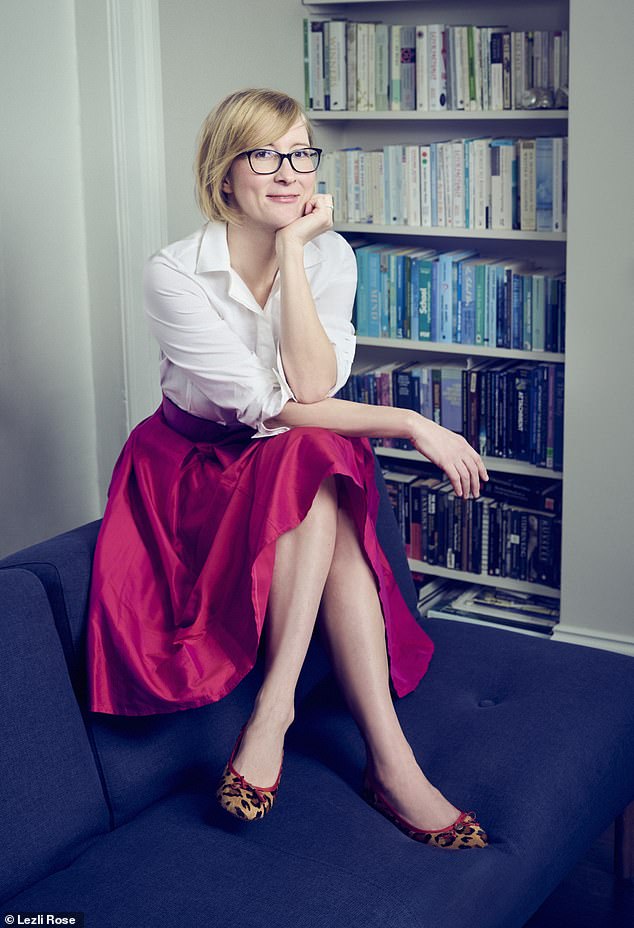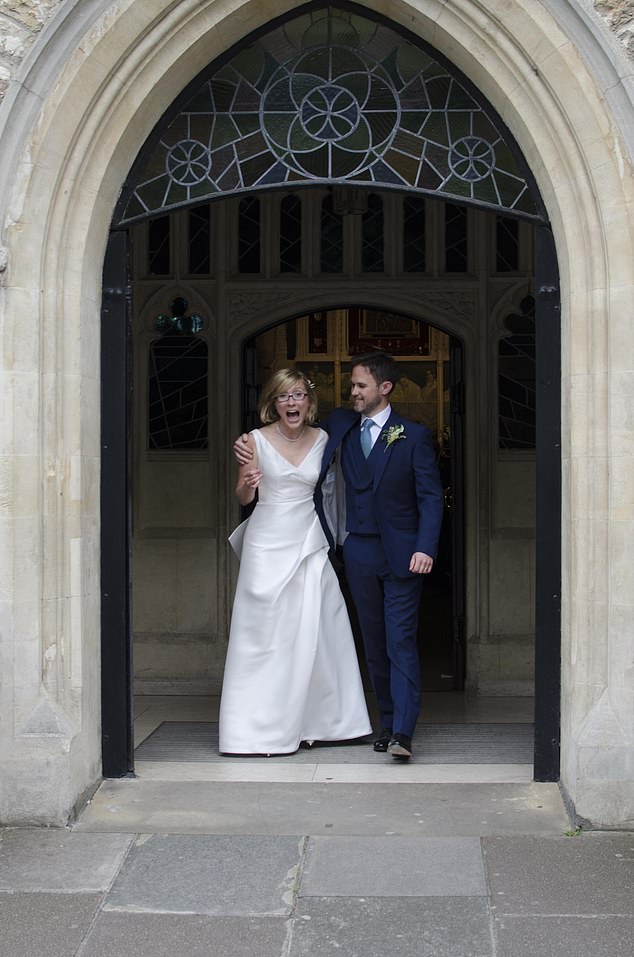I was in my late 20s when I realised that maybe I was the reason I was unlucky in love – and that it wasn’t just ‘bad luck’.
I had a close pair of married friends who’d set me up on dates in the past. Out of the blue, the wife mentioned that she and her husband had decided not to set me up with any more of their friends – ‘because you always break their hearts’.
What? Hearing that shocked me. I didn’t want to be that person – a heartbreaker or a commitment-phobe. But slowly, I realised there was truth in what they’d said.
I’d had a series of relationships through my 20s, all of them ended by me. In fact, I’d developed a pattern of dumping whoever I was seeing – for some reason, always at either the three-month or two-year mark.
Even Ed, who is now my husband, suffered the same fate when we first dated as law students in our early 20s. He made it to that two-year deadline, then I cut it dead. I don’t even know why I broke things off. I rarely did know. I just had this nebulous, indefinable feeling that something wasn’t right.
I think many people end promising relationships for similar reasons. After all, popular culture leads us to believe that true love will feel overwhelmingly right – perfect, even. But, for me, that simply wasn’t true.
Other people find themselves on the opposite end of the equation, being cruelly dumped by a series of partners without understanding why.
Whatever your situation, if you find yourself repeating the same negative patterns in relationships again and again, then my story might help you build a happier future.

Because I have finally managed to overcome my ‘heartbreaker’ pattern, and now, in my 40s, I’m happily married to Ed, the man I once unceremoniously broke up with.
It took many years of work and research – including writing two books about love and relationships – and even a car accident that upended my life and led to bringing to a close my career as a corporate lawyer.
It all started around 15 years ago when, perplexed by my friend’s comments, I threw myself into studying why my own relationships kept failing. The answers, I found, lay in something called ‘attachment theory’. You may well have heard of it, as it is the most widely studied psychological theory of the past 30 years (and the most misunderstood).
Loosely, the theory states that we are powerfully shaped by whether or not, in childhood, we have an ‘important person’ we can rely on. One who offers comfort and protection when we’re sad, scared or hurt and who recognises and responds to our needs.
For most of us, these ‘important people’ will have been our parents. If they were consistently there for us during our formative years, we will have what’s known as a ‘secure’ attachment with them.
If our parent figures didn’t prove to us that we could rely on them, we’re likely to have formed an ‘insecure’ attachment, which will impact everything from how easy we find it to form a healthy romantic relationship to how we raise our children.
Time and again the evidence has shown that securely attached adults are more likely to have healthy relationships, while those with insecure attachments are more likely to experience mental health issues and relationship problems.
Which one are you? It’s a 50-50 chance. Research suggests around half the population is securely attached, while the other half fits into one of the variations of insecure attachment.

If you suspect you’re in the latter group, as I was, you could benefit from learning more about attachment theory. It could be the answer to what is sabotaging your relationships and making you miserable.
My latest book, out this week, is about the powerful role attachment theory plays in our adult lives and how we can overcome the patterns that can cause so much heartbreak.
And my own story is powerful evidence that these patterns of behaviour can be changed; that we are not ‘stuck’ in whichever attachment pattern we have grown up with.
I was raised by my mother and her parents. I didn’t miss my biological father as a child – I never knew him, and I had so much love from three wonderful adults. But when I was 11, my grandfather died. He was the man I’d called Dad. He picked me up from school twice a week, played hours of catch with me in the garden – all the things an engaged and loving father would do.
For years after his death, the grief was so potent that any passing reminder of him would bring tears to my eyes. I coped by convincing myself that I was ‘fine’. I threw myself into studying and put every ounce of energy into being ‘OK’.
Although my mother and grandmother were there for me, my grandfather’s death shook my entire belief system. And, as a coping mechanism, I developed a form of insecure attachment known as ‘dismissive’.
Although secure attachment is usually seen as the ‘best’ type, there are some advantages to the other attachment styles.
For example, in my first career as a corporate lawyer my insecure attachment served me well, helping me to be ‘fine’ under the pressure of important financial crime cases.

Research shows that, in corporate environments, there is a higher proportion of people whose attachment pattern downplays negative feelings – many people there are ‘fine’, because they have learned they always have to be. Still, the more I learned about attachment theory, the more I questioned my behaviour in relationships.
Then, when I was 29, a dramatic event changed the course of my life. I was walking across the road and a taxi driver came flying around the corner into me. I flew backwards into the air before landing in the middle of the road, with my belongings spread across the tarmac.
I remember very clearly asking the paramedic in the ambulance: ‘Is it reasonable that I’m crying?’
Not exactly the question of someone comfortable with experiencing or showing emotions. He reeled off all the different ways he’d seen people react, when all I really wanted was for him to tell me it was OK to cry.
That accident set off several years of health issues and endless hours in hospital waiting rooms. I took a great deal of time off work and immersed myself in writing my first book.
But the real surprise of that time was that, through it all, Ed took it upon himself to be there. We’d split up five years before, but had recently met again at a party. Suddenly, he was there for me – cycling to visit me, bringing me food, spending time with me at my lowest ebb.
I was very much interested in him, but couldn’t see why he’d want me. I felt I had very little going for me. It was an incredibly humbling experience to be cared for so selflessly and, eventually, we started dating again.
I believe it was during this time, thanks to both Mum and Ed being there for me without question, that I managed to change the ingrained pattern that began with losing my grandfather and become securely attached.
While writing my book I had my attachment pattern formally assessed in an intense, scientific interview lasting several hours. The specially trained coder confirmed that my attachment pattern is now secure.
Of course, becoming secure doesn’t mean things become perfect and easy and you never have to think about it again.
When Ed proposed three years later, my overwhelming feeling was one of anxiety.
Standing on an Australian beach, having this exceptional human tell me he wanted to be by my side for life, I was drenched in apprehension. I said yes – but it was a reserved yes, not an ecstatic one like in the films.
Happily, though, I knew enough about myself at that point to be able to say to him: ‘I’m really sorry, I appreciate that anxiety is not what you want right now, but this is just my attachment system throwing a wobbly.’
Far from romantic. But Ed, as ever, was calm about it – he’d come to understand my quirks.
It took one or two weeks, but I relaxed into my ‘yes’ and I’m so glad I’d said it.
I know for a fact that if I’d not learned so much about attachment theory, there’s no way Ed and I would be married now, nor be confidently raising our darling son in the happy home we’ve created together.
These days, Ed and I work so hard to show our son, who’s in primary school, that we are there for him no matter what. When we are with him, we try to be as present as possible, interested in what’s going on for him and keen to listen to the things he’s finding difficult.
Society would have us believe that ‘too much love’ or attention can spoil or smother a child. But research tells us that, more than anything, children need family and other people who are emotionally available and who they can trust.
However, if your relationship with your parents wasn’t like this, it’s important to know that you’re not ‘doomed’.
No matter how difficult your childhood relationships were, you’re not bound by them: through self-awareness, and finding close friendships and relationships with people who are truly there for you, you can change. Research – and my own experience – proves it.
As told to Libby Galvin
- Please Find Attached: How Attachment Theory Explains Our Relationships, by Laura Mucha, is published today by Bloomsbury Sigma.
How your ‘attachment type’ can sabotage your relationships
Here is a guide to help kickstart your journey of self-discovery…
Securely attached: You know, believe or feel that ‘someone important’ will be there for you when you need them.
This belief is based on the experiences of formative relationships in your childhood and beyond – and it can mean you have better relationships and better mental health.
You don’t worry about whether or not someone will be there for you. You don’t spend your time preoccupied with how others feel about you and you won’t become obsessive about, or afraid of, intimacy.
You recognise the value of important relationships, can talk about the good and bad and are there for important people when needed.
Upset? A secure person will listen and be sensitive to needs – like realising you might need a hug.
Insecurely attached: You don’t know or believe that someone important will be there for you when you need them. Researchers have come up with different types of insecure attachment – although consider these fluid outlines, rather than strict definitions, as these labels are easy to get wrong or may overlap. You can be ‘avoidant’ but not ‘dismissive’ and vice versa.
What they all have in common is that you don’t believe someone will be there for you, which manifests in different ways.
Preoccupied: When you needed help as a child, sometimes you got it, sometimes not. You knew someone important would be there for you, just not when. You spent a lot of time focused on whether they were available or not and were angry if they weren’t.
As adults, people with this pattern spend energy focusing on important relationships. But instead of seeing the good and bad in a balanced way, focus on the negatives.
Dismissive: When you asked for help as a child, you didn’t get it or you were rejected or punished. So, you learned not to ask and distracted yourself so you didn’t feel upset.
You focus your attention away from important relationships, ‘dismissing’ the idea that you need anyone else. You often describe having had an idyllic upbringing, but don’t have specific memories to back this up.
That may be because you’ve blocked your childhood from your awareness to protect yourself or you recall challenging events but find it difficult to tell others.
Anxious: You worry about how strong your relationships are. You are very concerned with the desire to be close to someone.
You often think about whether others are there for you or not, and need their support more. Your threshold for what you see as a crisis in life is lower.
Avoidant: You believe that if you try to get close to someone, you’ll be rejected. You either worry about getting close, or are reluctant to depend on others.
This means you don’t ask other people to be there for you – even in times of crisis.

